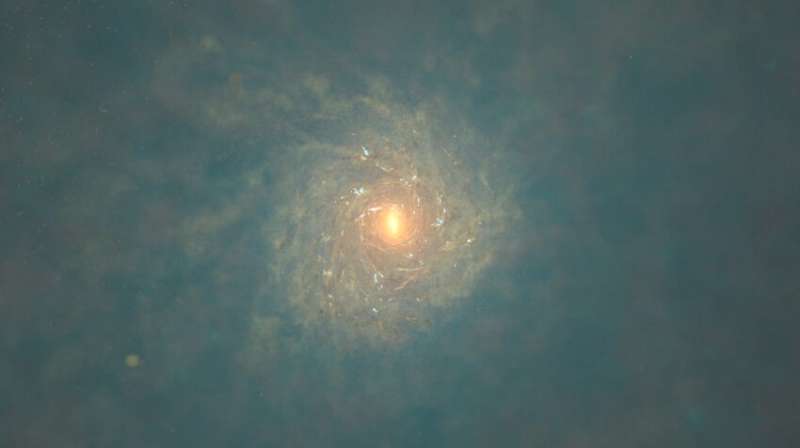
A team of researchers from the University of Notre Dame and Tohoku University have revealed the birthplace of so-called "gold-rich" stars—stars with an abundance of heavy elements beyond iron, including the "jewelry store elements," gold and platinum. Their research is published in the Monthly Notices of the Royal Astronomical Society.
Hundreds of gold-rich stars have been discovered by state-of-the-art telescopes worldwide. The mystery was when, where, and how these stars were formed in the history of the Milky Way, the galaxy we live in. The team found that most gold-rich stars formed in small progenitor galaxies of the Milky Way over 10 billion years ago, shedding light on the stars' past for the first time.
In order to reach this conclusion, the team tracked the Milky Way's formation from the Big Bang to the present with a numerical simulation. This simulation has the highest time resolution yet achieved—it can precisely resolve the cycle of materials formed by stars in the Milky Way. The simulation was produced over several months using the ATERUI II supercomputer in the Center for Computational Science at the National Astronomical Observatory of Japan.
The simulation made it possible to analyze the formation of gold-rich stars in the Milky Way for the first time. The standard cosmology it used predicts that the Milky Way grows by the accretion and merging of small progenitor galaxies.
The simulation data revealed that some of the progenitor galaxies—that existed over 10 billion years ago—contained large amounts of the heaviest elements. Each event of neutron star merger—a confirmed site of heavy element nucleosynthesis—increased the abundance of the heaviest elements in these small galaxies. The gold-rich stars formed in these galaxies, and their predicted abundances can be compared with the observations of the stars today.
Yutaka Hirai, of Tohoku University, says, "The gold-rich stars today tell us the history of the Milky Way—we found most gold-rich stars are formed in dwarf galaxies over 10 billion years ago. These ancient galaxies are the building blocks of the Milky Way. Our findings mean many of the gold-rich stars we see today are the fossil records of the Milky Way's formation over 10 billion years ago." He adds, "Comparison with simulations and observations in the Milky Way opens a new avenue for extracting the fossil records of stars."
The research appears as "Neutron star mergers as the astrophysical site of the r-process in the Milky Way and its satellite galaxies," published in Monthly Notices of the Royal Astronomical Society.
More information: Yutaka Hirai et al, Origin of highly r-process-enhanced stars in a cosmological zoom-in simulation of a Milky Way-like galaxy, Monthly Notices of the Royal Astronomical Society (2022). DOI: 10.1093/mnras/stac2489
Provided by Royal Astronomical Society
Citation: Research unveils birthplace of gold-rich stars (2022, November 14) retrieved 14 November 2022 from https://phys.org/news/2022-11-unveils-birthplace-gold-rich-stars.html
This document is subject to copyright. Apart from any fair dealing for the purpose of private study or research, no part may be reproduced without the written permission. The content is provided for information purposes only.
https://news.google.com/__i/rss/rd/articles/CBMiRWh0dHBzOi8vcGh5cy5vcmcvbmV3cy8yMDIyLTExLXVudmVpbHMtYmlydGhwbGFjZS1nb2xkLXJpY2gtc3RhcnMuaHRtbNIBAA?oc=5
2022-11-14 16:05:03Z
CAIiEAjfI5jfO6qBS26DC-KfwXoqFwgEKg8IACoHCAowpbDpAzCm_hwwj9kp
Tidak ada komentar:
Posting Komentar